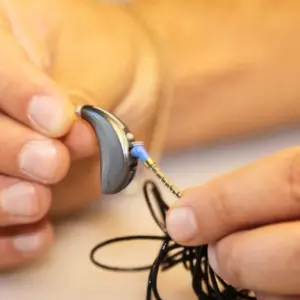Banishing the Buzz: Eliminating Hearing Aid Feedback
Hearing aid feedback, that unwelcome high-pitched whistle or squeal from your hearing aids, isn’t something you have to live with. Fortunately, it’s often a fixable issue. In this detailed exploration, we’ll uncover the causes of hearing aid feedback and offer practical solutions to enhance your listening experience.
Exploring the Roots of Hearing Aid Feedback
Let’s delve deeper into the triggers of hearing aid feedback, a critical step toward understanding and addressing this common issue. When sound escapes your ear canal and re-enters the hearing aid microphone, it creates a loop that amplifies the sound into what we recognize as feedback. This loop can disrupt your listening experience and requires prompt attention. Here are the main culprits:
Acoustic Feedback: The Common Intruder
Acoustical feedback is perhaps the most frequent cause of hearing aid feedback. It usually happens when the hearing aid doesn’t fit perfectly in your ear. This improper fit allows sound to “leak” out and re-enter the microphone. Several factors contribute to this:
- Improper Fit: If the hearing aid or earmold doesn’t match the contours of your ear perfectly, gaps can form, allowing sound to escape.
- Earwax Buildup: Earwax can block the sound from traveling correctly through the ear canal, causing the sound to bounce back toward the microphone.
Understanding and addressing these factors is essential for preventing acoustical feedback. Regular check-ins with your audiologist can ensure your hearing aid fits well and that earwax buildup doesn’t affect how it works.

Mechanical Feedback: When Parts Misalign
Mechanical feedback occurs when internal components of the hearing aid vibrate against each other or the casing. This situation might arise due to:
- Loose Components: Over time, parts within your hearing aid may become loose, especially with regular use or after accidental drops.
- Speaker-Casing Contact: If the speaker (or receiver) makes physical contact with the hearing aid’s casing, it can create vibrations picked up as feedback.
Tackling mechanical feedback often requires professional attention to tighten loose components or adjust the speaker’s placement to avoid contact with the casing.
Electronic Feedback: The Electric Enigma
Although less common, electronic feedback is a complex issue related to the hearing aid’s internal circuitry. This type of feedback may manifest due to:
- Circuitry Problems: Faults within the hearing aid’s electronic components can create unwanted feedback loops.
- Software Glitches: Occasionally, software issues within the hearing aid can result in feedback requiring firmware updates or adjustments by the manufacturer.
Addressing electronic feedback typically involves technical diagnostics and repairs by a qualified audiologist or a return to the manufacturer for more in-depth service.
Find out more about how hearing aids work.
The First Step to Solution
Identifying the type of feedback you’re experiencing is crucial. Each type has its own set of solutions, and understanding the root cause enables you and your audiologist to develop a targeted approach to resolve the issue. Regular maintenance, proper fitting, and professional consultations are critical strategies for managing hearing aid feedback effectively. By taking these steps, you can significantly improve your hearing aid’s performance and your overall listening experience.
Addressing the Challenge: Solutions for Hearing Aid Feedback
Each type of feedback presents its own set of challenges, but there are effective solutions for each:
- For Mechanical Feedback: Ensure all components are tight and properly aligned. If there are rubbing or loose parts, visiting your hearing center can resolve these issues.
- For Acoustic Feedback: Achieving a proper fit is paramount. Regular cleaning to remove earwax and adjusting your hearing aid’s volume and settings can also prevent sound leakage.
- For Electronic Feedback: Investigate any potential defects or software issues with your audiologist, who can guide you on the next steps, including repairs or updates.
Looking at these solutions, it’s clear that addressing this problem often requires a combination of professional support and regular maintenance of your device.

Working With Your Hearing Care Provider
Your audiologist is an indispensable partner in managing hearing aid feedback. They bring a wealth of knowledge and tools to the table:
Hearing specialists can diagnose the specific cause of feedback, whether mechanical, acoustic, or electronic, and tailor a solution to your needs. Additionally, they can adjust or replace parts for mechanical and acoustic feedback, ensuring your hearing aid’s proper fit and function. Providers also handle electronic feedback, offering repairs, software updates, or replacements as needed.
Beyond addressing the immediate technical issues causing feedback in your current hearing aids, your audiologist plays a pivotal role in guiding you toward long-term solutions. One of the most effective strategies involves considering new hearing aids with advanced feedback suppression technologies.
Discover more about when to get new hearing aids.
Advising on Cutting-Edge Models That Prevent Hearing Aid Feedback
Your audiologist stays updated on the latest advancements in hearing aid technology. They can recommend models that feature the most advanced feedback suppression systems. These systems recognize and cancel out feedback before it reaches your ear, offering a more comfortable and clear listening experience.
Demonstrating New Technologies
Many modern hearing aids have digital signal processing (DSP) and feedback management features like phase cancellation and notch filtering. Your audiologist can demonstrate how these technologies work to control feedback, giving you a clearer understanding of their benefits.
Exploring new models with your audiologist can open the door to a world of improved hearing experiences, where feedback becomes a thing of the past. This proactive approach not only enhances your immediate quality of life but also secures your hearing health for years to come.
In Summary: A Path to Clearer Hearing
Dealing with hearing aid feedback is a journey toward clearer, more comfortable listening. Understanding the causes and knowing the solutions are the first steps. Yet, the most effective approach combines these strategies with ongoing support from your audiologist.
Schedule an appointment with Stanford Hearing if you’re struggling with feedback or any other hearing aid concerns. Our team provides personalized care, from diagnosing issues to recommending the latest in hearing aid technology. Let us help you navigate your hearing health journey with confidence and clarity.
